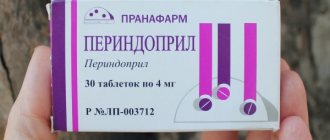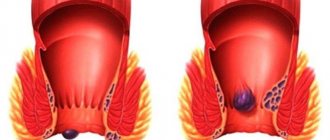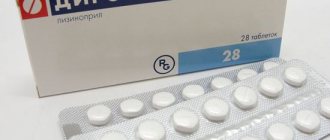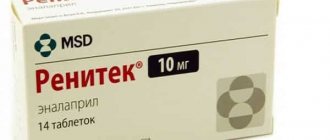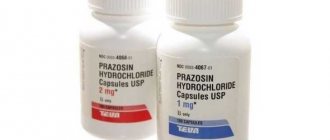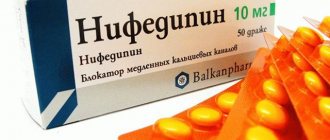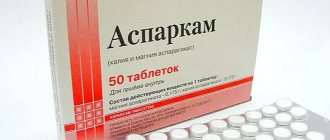What is it used for?
The drug is intended for the correction of hypertension, primary and secondary.
The drug can be taken only on the recommendation of the attending physician based on examination of the patient. The specialist must conduct a physical examination, perform an electrocardiogram and ultrasound of the heart (if necessary), examine the structure of the fundus (it is damaged by hypertension). The final diagnosis is based on measuring blood pressure over time. If the indicators are consistently exceeded 140/90 mmHg. Art. A diagnosis of arterial hypertension is made. The doctor is faced with a choice between different groups of drugs that have a hypotensive effect by influencing the mechanisms that cause an increase in blood pressure. The choice of active substance is based on the patient’s health status and is selected in such a way as to obtain the maximum therapeutic effect and minimize side effects.
The drug contains a selective beta-blocker and a calcium channel blocker (CCB).
A beta-blocker inhibits the reaction of beta-adrenergic receptors to the action of the adrenal hormones adrenaline and norepinephrine, under the influence of which inotropic reactions occur. Bisoprolol, suppressing beta-adrenergic receptors, acts as follows:
- slows down the pulse (HR);
- reduces the conductivity of the heart muscle;
- reduces myocardial contractility;
- reduces the heart's need for oxygen;
A calcium channel blocker is a drug that selectively stops the flow of calcium ions into cells through the “slow” L-type channels. CCB has a negative inotropic and vasodilating effect. Amlodipine produces the following effects:
- affects the transmembrane entry of calcium ions into cardiomyocytes during excitation, reducing the breakdown of adenosine triphosphate (ATP);
- reduces the force of contraction and the heart’s need for oxygen;
- reduces vascular tone, preventing vasospasm;
- reduces afterload on the heart;
- increases blood flow in ischemic areas of the heart;
- slows down the appearance of atherosclerotic plaques.
CCB has a different mechanism of action on the heart and blood vessels; it produces a pronounced hypotensive effect. In combination, a CCB and a beta-blocker help to effectively reduce blood pressure and keep it within normal limits due to a synergistic effect. The drugs complement each other, exerting a selective effect on the mechanisms that cause an increase in blood pressure. There are no other side effects associated with negative inotropic and vasodilating effects.
Consequences of arterial hypertension for the human body
Effect on potency
How is the drug "Concor" and potency related? Does this medication really have an effect on male potency? Is it possible to somehow avoid this or minimize the side effects? Let's look at these questions next. The breakdown products of the drug are excreted from the body by the kidneys, so there is a direct effect of metabolites on the male genitourinary system. Sexual functions are inhibited, which interferes with healthy sexual activity. At the same time, scientists have not yet found the answer to whether this drug affects erection more than the disease itself and its symptoms.
Bisoprolol (the active component of the drug in question) can indeed affect male potency by reducing blood flow in the pelvic organs. This is noted by many men suffering from hypertension and heart disease who have been prescribed this remedy. However, doctors believe that not everything is so simple. After all, the diseases for which this drug is prescribed themselves significantly disrupt the functioning of a number of important systems, which is why sexual function also suffers. In particular, the following consequences from hypertension and cardiovascular diseases are noted:
- The appearance of disturbances in the blood vessels leads to a sharp decrease in the content of oxygen and nutritional ingredients in various tissues, including such important organs for potency as the testicles and prostate gland.
- Changes in the functioning of the heart cause a deterioration in physical abilities, such as endurance, and this greatly interferes with the performance of full sexual intercourse.
- Deviations in kidney function cause changes in the salt and water balance in the body, and this affects hormonal levels.
Overdose
Amlodipine
Symptoms of amlodipine overdose may include a significant decrease in blood pressure with the possible development of severe peripheral vasodilation and the occurrence of reflex tachycardia (the risk of severe and persistent arterial hypotension with the risk of shock and death increases).
For these symptoms, gastric lavage, activated charcoal, and measures aimed at maintaining the function of the cardiovascular system are prescribed. They monitor the performance of the heart and lungs, control the circulating blood volume (CBV) and diuresis. The patient's lower extremities are placed in an elevated position and intensive symptomatic therapy is carried out. In order to restore vascular tone, vasoconstrictors are prescribed (in the absence of contraindications); To relieve the effects of calcium channel blockade, calcium gluconate is administered intravenously (IV). Hemodialysis is ineffective.
Bisoprolol
Symptoms of an overdose of bisoprolol can be bronchospasm, a pronounced decrease in blood pressure, severe bradycardia, AV block, acute heart failure, hypoglycemia. Among individual patients, sensitivity to a single dose of large doses of bisoprolol varies significantly and patients with CHF are likely to have high sensitivity.
If an overdose is suspected, it is necessary to stop taking the drug and carry out supportive symptomatic treatment.
If the development of severe bradycardia is observed, atropine is administered intravenously; if the effect is insufficient, careful administration of drugs with a positive chronotropic effect can be prescribed. In some cases, a temporary pacemaker may be installed
With a pronounced decrease in blood pressure, plasma-substituting solutions and vasopressor drugs are infused intravenously. IV administration of glucagon may also be prescribed. With the development of AV blockade (II-III degree), constant monitoring of the condition and the administration of β-adrenergic agonists (including epinephrine), as well as infusion of isoprenaline, are required; if necessary, a pacemaker is installed.
In case of exacerbation of CHF, diuretics, drugs with a positive inotropic effect and vasodilators are administered intravenously.
For bronchospasm, bronchodilators are prescribed, including β2-adrenergic agonists and/or aminophylline; for hypoglycemia, dextrose (glucose) is administered intravenously.
During dialysis, bisoprolol is almost not excreted.
Side effects
Concor belongs to the group of strong beta blockers of the new generation. Designed to reduce blood pressure, but at the same time it can lead to the development of erectile dysfunction, other complications, side effects and effects.
When using the drug, there is a direct effect on the nervous system, which can in turn provoke unpleasant symptoms:
Fatigue and drowsiness
- distortion of color perception;
- drowsiness;
- dizziness;
- fear without reason;
- chronic fatigue;
- headache;
- excessive feeling of anxiety;
- nightmares;
- chronic fatigue.
Constant manifestations of such symptoms do not have the best effect on the psycho-emotional background of men, in particular the reproductive system, ultimately leading to impotence and erectile function disorders. So, if at an early stage there is a lack of ejaculation, and ejaculation comes 2-3 hours late at the moment of intimacy after excitability, then over time the disease will begin to progress and problems with erection may become obvious.
On a note? If you experience constant depression or suicidal tendencies while taking Concor, then it is better to give up and look for gentle analogues with a different chemical composition. If there are signs of an overdose and a toxic effect, then you urgently need to rinse your stomach, drink an activated charcoal tablet, visit a therapist or urologist
Contraindications
For amlodipine:
- unstable angina (except Prinzmetal's angina);
- acute myocardial infarction (during the first 28 days);
- obstruction of the left ventricular outflow tract (including clinically significant aortic stenosis).
For bisoprolol:
- acute heart failure or CHF in the stage of decompensation, requiring inotropic support;
- atrioventricular (AV) block of II–III degree, in the absence of a pacemaker;
- sinoatrial block;
- sick sinus syndrome (SSNS);
- severe bradycardia with heart rate below 60 beats/min;
- Raynaud's syndrome or severe peripheral arterial circulation disorders;
- severe forms of bronchial asthma or chronic obstructive pulmonary disease (COPD);
- metabolic acidosis;
- pheochromocytoma (without combined use with α-blockers).
For the combination of amlodipine + bisoprolol:
- age under 18 years;
- shock (including cardiogenic);
- severe arterial hypotension (systolic blood pressure below 100 mm Hg);
- hypersensitivity to the active components of the drug (including other dihydropyridine derivatives) and/or to any of the additional substances.
Concor AM should be used with extreme caution for the following conditions/diseases:
- CHF, including non-ischemic etiology, functional class III–IV according to the NYHA classification (New York Heart Association);
- Prinzmetal's angina;
- AV block of the first degree;
- mild/moderate degree of peripheral arterial circulation disorders;
- arterial hypotension;
- acute myocardial infarction (after the first 28 days);
- hypertrophic obstructive cardiomyopathy;
- aortic/mitral stenosis;
- bronchial asthma and COPD;
- liver and/or kidney failure;
- concomitant desensitizing therapy (since bisoprolol can lead to increased sensitivity to allergens and increased anaphylactic reactions);
- pheochromocytoma (in combination with α-blockers);
- diabetes mellitus, characterized by significant fluctuations in blood glucose levels;
- carrying out general anesthesia;
- hyperthyroidism (bisoprolol can mask the symptoms of the disease);
- type 1 diabetes mellitus;
- psoriasis (including history);
- elderly age;
- fasting (strict diet).
special instructions
It is not recommended to abruptly discontinue the drug and adjust the dosage yourself. Especially with coronary heart disease. If it is necessary to discontinue use, then the daily dosage must be reduced gradually. At the initial stage, you need to regularly visit a cardiologist.
The drug is used with caution in the following situations:
- severe forms of chronic obstructive pulmonary disease and bronchial asthma;
- restrictive cardiomyopathy;
- low calorie diet;
- Prinzmetal's angina;
- diabetes;
- psoriasis;
- desensitizing treatment.
For bronchial asthma, bisoprolol is used in conjunction with bronchodilating drugs. Possible shortness of breath, cough, intolerance
During pregnancy and breastfeeding
Bisoprolol penetrates the placental barrier and disrupts the blood circulation of the fetus. During the period of embryonic development, it is recommended to take the drug only in extreme cases, when the therapeutic effect for the pregnant woman outweighs the potential risk to the fetus.
There is no data on the penetration of the active substance into breast milk, and therefore lactation must be stopped during drug therapy.
Bisoprolol penetrates the placental barrier and disrupts the blood circulation of the fetus.
In children
Prohibited for children under 18 years of age.
In the elderly
No additional dosage adjustment is required.
For liver dysfunction
In case of severe liver diseases, the maximum daily dosage of the drug should not exceed 10 mg.
For impaired renal function
In case of renal failure, caution must be exercised. When creatinine clearance is less than 20 ml/min, the maximum dosage should not be higher than 10 mg.
In case of renal failure, caution must be exercised.
Pharmadynamics
This drug has pronounced antihypertensive and antianginal effects due to the complementary action of two active ingredients: the CCB - amlodipine and the selective beta1-blocker - bisoprolol.
Amlodipine
Mechanism of action. Amlodipine blocks calcium channels, reduces the transmembrane transition of calcium ions into the cell (more into vascular smooth muscle cells than into cardiomyocytes).
The antihypertensive effect of amlodipine is due to a direct relaxing effect on vascular smooth muscle cells, which leads to a decrease in peripheral vascular resistance.
The mechanism of antianginal action is not fully understood; it may be associated with the following two effects:
1. The expansion of peripheral arterioles reduces peripheral vascular resistance, i.e. afterload. Since amlodipine does not cause reflex tachycardia, myocardial energy and oxygen consumption is reduced.
2. Dilatation of large coronary arteries and coronary arterioles improves oxygen supply to both normal and ischemic areas of the myocardium. Thanks to these effects, the supply of oxygen to the myocardium is improved even with spasm of the coronary arteries (Prinzmetal's angina or unstable angina).
In patients with arterial hypertension, taking the drug once a day causes a clinically significant decrease in blood pressure in the supine and standing positions throughout the entire 24-hour interval between doses of the drug. Due to the slow development of the antihypertensive effect of amlodipine, it does not cause acute arterial hypotension.
In patients with angina, taking the drug once a day increases the total time of physical activity, the time before the development of an angina attack, as well as the time until a significant decrease in the ST1 mm interval and reduces the frequency of angina attacks and the need for sublingual nitroglycerin.
Amlodipine is not associated with any adverse metabolic effects or changes in plasma lipids. Can be used in patients with asthma, diabetes and gout.
Bisoprolol
Mechanism of action. Bisoprolol is a selective beta1-blocker, without its own sympathomimetic activity, and does not have a membrane-stabilizing effect.
It has only slight affinity for beta2-adrenergic receptors of the smooth muscles of the bronchi and blood vessels, as well as for beta2-adrenergic receptors involved in the regulation of metabolism. Therefore, bisoprolol generally does not affect airway resistance and metabolic processes in which beta2-adrenergic receptors are involved.
The selective effect of the drug on beta1-adrenergic receptors persists beyond the therapeutic range.
Bisoprolol does not have a pronounced negative inotropic effect.
The maximum effect of the drug is achieved 3–4 hours after oral administration.
Even when bisoprolol is prescribed once a day, its therapeutic effect persists for 24 hours due to the 10-12 hour T1/2 from blood plasma. As a rule, the maximum antihypertensive effect is achieved 2 weeks after the start of treatment.
Bisoprolol reduces the activity of the sympathoadrenal system by blocking beta1-adrenergic receptors of the heart.
When administered once orally in patients with coronary artery disease without signs of CHF, bisoprolol reduces heart rate, reduces the stroke volume of the heart and, as a result, reduces the ejection fraction and myocardial oxygen demand. With long-term therapy, the initially elevated TPR decreases. A decrease in renin activity in blood plasma is considered as one of the components of the hypotensive effect of beta-blockers.
Concor am
pharmachologic effect
The drug has pronounced antihypertensive and antianginal effects due to the complementary action of two active ingredients: BMCC - amlodipine and a selective beta1-blocker - bisoprolol.
Amlodipine
Amlodipine blocks calcium channels, reduces the transmembrane transition of calcium ions into the cell (more into vascular smooth muscle cells than into cardiomyocytes).
The antihypertensive effect of amlodipine is due to a direct relaxing effect on vascular smooth muscle cells, which leads to a decrease in peripheral vascular resistance.
The mechanism of antianginal action is not fully understood; it may be associated with the following two effects:
1.Dilation of peripheral arterioles reduces peripheral vascular resistance, i.e. afterload. Since amlodipine does not cause reflex tachycardia, myocardial energy and oxygen consumption is reduced.
2. Dilatation of large coronary arteries and coronary arterioles improves oxygen supply to both normal and ischemic areas of the myocardium. Thanks to these effects, the supply of oxygen to the myocardium is improved, even with spasm of the coronary arteries (Prinzmetal's angina or unstable angina). In patients with arterial hypertension, taking the drug once a day causes a clinically significant decrease in blood pressure in the supine and standing positions throughout the entire 24-hour interval between doses of the drug. Due to the slow development of the antihypertensive effect of amlodipine, it does not cause acute arterial hypotension.
In patients with angina pectoris, taking the drug once a day increases the total time of physical activity, the time before the development of an angina attack, as well as the time until a significant decrease in the ST interval, and also reduces the frequency of angina attacks and the need for sublingual nitroglycerin.
No negative effect of amlodipine on the metabolism of plasma lipids, blood glucose and serum uric acid was detected.
Bisoprolol
Bisoprolol is a selective beta1-blocker, without its own sympathomimetic activity, and does not have a membrane-stabilizing effect.
It has only slight affinity for β2-adrenergic receptors of the smooth muscles of the bronchi and blood vessels, as well as for β2-adrenergic receptors involved in the regulation of metabolism. Therefore, bisoprolol generally does not affect airway resistance and metabolic processes in which β2-adrenergic receptors are involved.
The selective effect of the drug on beta1-adrenergic receptors persists beyond the therapeutic range.
Bisoprolol does not have a pronounced negative inotropic effect.
The maximum effect of the drug is achieved 3-4 hours after oral administration. Even when bisoprolol is prescribed once a day, its therapeutic effect persists for 24 hours due to 10-12 hours T1/2 from blood plasma. As a rule, the maximum antihypertensive effect is achieved 2 weeks after the start of treatment.
Bisoprolol reduces the activity of the sympathoadrenal system (SAS) by blocking β1-adrenergic receptors of the heart.
When administered once orally in patients with coronary artery disease without signs of chronic heart failure, bisoprolol reduces heart rate, reduces the stroke volume of the heart and, as a result, reduces the ejection fraction and myocardial oxygen demand. With long-term therapy, the initially elevated TPR decreases. A decrease in renin activity in blood plasma is considered as one of the components of the hypotensive effect of beta-blockers.
Pharmacokinetics
Amlodipine
Suction
Amlodipine is well absorbed after oral administration. Cmax in blood plasma is observed after 6-12 hours. Taking the drug with food does not affect its absorption. Absolute bioavailability is 64-80%.
Distribution
Apparent Vd is 21 l/kg. Equilibrium concentration in blood plasma (5-15 ng/ml) is achieved 7-8 days after starting the drug.
In vitro studies have shown that circulating amlodipine is approximately 93-98% bound to plasma proteins.
Metabolism and excretion
Amlodipine undergoes extensive metabolism in the liver. Approximately 90% of the dose taken is converted into inactive pyridine derivatives. Approximately 10% of the dose taken is excreted unchanged in the urine. Approximately 60% of the amount of inactive metabolites is excreted by the kidneys and 20-25% through the intestines. The decrease in plasma concentration is biphasic. The final T1/2 is approximately 35-50 hours, which allows the drug to be administered once a day. The total clearance is 7 ml/min/kg (25 l/h in a patient weighing 60 kg). In elderly patients it is 19 l/h.
In elderly patients and patients with renal impairment, no significant changes in the pharmacokinetics of amlodipine were observed.
Due to decreased clearance, patients with hepatic impairment should be given lower initial doses.
Bisoprolol
Suction
Bisoprolol is almost completely (more than 90%) absorbed from the gastrointestinal tract. Its bioavailability due to low first-pass metabolism through the liver (at approximately 10%) is approximately 90% after oral administration. Food intake does not affect bioavailability. Bisoprolol exhibits linear kinetics, with its plasma concentrations being proportional to the dose taken in the range from 5 to 20 mg. Cmax in blood plasma is achieved after 2-3 hours.
Distribution
Bisoprolol is distributed quite widely. Vd is 3.5 l/kg. Plasma protein binding reaches approximately 30%.
Metabolism
Metabolized via the oxidative pathway without subsequent conjugation. All metabolites are polar (water-soluble) and are excreted by the kidneys. The main metabolites found in blood plasma and urine do not exhibit pharmacological activity. Data obtained from experiments with human liver microsomes in vitro show that bisoprolol is metabolized primarily by the CYP3A4 isoenzyme (about 95%), and the CYP2D6 isoenzyme plays only a minor role.
Removal
The clearance of bisoprolol is determined by the balance between excretion by the kidneys unchanged (about 50%) and metabolism in the liver (about 50%) to metabolites, which are also excreted by the kidneys. The total clearance is 15 l/h. T1/2 -10-12 hours.
Indications
- arterial hypertension: replacement of therapy with monocomponent drugs amlodipine and bisoprolol in the same doses.
Dosage regimen
Tablets for oral administration. The tablets should be taken in the morning, regardless of meals, without chewing.
The recommended daily dose is 1 tablet/day of a certain dosage.
The selection and titration of the dose individually for each patient is carried out by the doctor when prescribing monocomponent drugs containing the active ingredients included in the drug Concor® M.
Treatment with Concor® M is usually long-term therapy.
In patients with impaired liver function
elimination of amlodipine may be delayed. A special dosage regimen for this group of patients has not been determined, however, the drug in this case should be prescribed with caution.
For patients with severe liver dysfunction
The maximum daily dose of bisoprolol is 10 mg.
mild or moderate
renal impairment , dosage regimen adjustment is usually not required. Amlodipine is not eliminated by dialysis. Patients undergoing dialysis should be prescribed amlodipine with extreme caution.
For patients with severe renal impairment (creatinine clearance (CC) less than 20 ml/min)
The maximum daily dose of bisoprolol is 10 mg.
Elderly patients
Regular doses of the drug may be prescribed. Caution is required only when increasing the dose.
The drug is not recommended for use in children under 18 years of age
due to the lack of data on effectiveness and safety.
Treatment should not be stopped abruptly, as this may lead to a temporary deterioration of the clinical condition. Especially treatment should not be abruptly stopped in patients with coronary artery disease. A gradual dose reduction is recommended.
Side effect
Undesirable side reactions observed when using active ingredients separately are presented in accordance with the following frequency grouping criteria: very common ≥1/10; frequent ≥1/100 - <1/10; uncommon ≥1/1,000 - <1/100; rare ≥1/10,000 - <1/1,000; very rare (<1/10,000), unknown (cannot be estimated based on available data).
Amlodipine
From the hematopoietic system:
very rarely - leukopenia, thrombocytopenia.
From the immune system:
very rarely - allergic reactions.
Metabolism and nutrition:
very rarely - hyperglycemia.
Mental disorders:
uncommon - insomnia, mood changes (including anxiety), depression; rarely - confusion.
From the nervous system:
often - headache, dizziness, drowsiness (especially at the beginning of treatment); infrequently - fainting, hypoesthesia, paresthesia, dysgeusia, tremor; very rarely - muscle hypertension, peripheral neuropathy.
From the side of the organ of vision:
infrequently - visual impairment (including diplopia).
Hearing and labyrinth disorders:
infrequently - tinnitus.
From the digestive system:
often - nausea, abdominal pain; infrequently - change in bowel habits (including constipation or diarrhea), dyspepsia, dryness of the oral mucosa; very rarely - gastritis, gingival hyperplasia, pancreatitis.
From the liver and biliary tract:
very rarely - hepatitis (in most cases with cholestasis), jaundice (in most cases with cholestasis).
From the cardiovascular system:
often - palpitations, flushing of the face; infrequently - pronounced decrease in blood pressure; very rarely - myocardial infarction, arrhythmia (bradycardia, ventricular tachycardia, atrial fibrillation), vasculitis.
From the respiratory system:
infrequently - shortness of breath, rhinitis; very rarely - cough.
From the urinary system:
infrequently - pollakiuria, painful urge to urinate, nocturia.
From the genital organs and breast:
infrequently - impotence, gynecomastia.
General disorders and disorders at the injection site:
often - peripheral edema, increased fatigue; uncommon - chest pain, asthenia, pain, general malaise.
From the musculoskeletal system:
often - swelling of the ankles; uncommon - arthralgia, myalgia, muscle cramps, back pain.
For the skin and subcutaneous tissues:
uncommon - alopecia, purpura, skin discoloration, increased sweating, itching, rash, exanthema; very rarely - angioedema, erythema multiforme, urticaria, exfoliative dermatitis, Stevens-Johnson syndrome, Quincke's edema, photosensitivity.
Laboratory and instrumental data:
uncommon - weight gain, weight loss; very rarely - increased activity of liver enzymes in most cases with cholestasis.
Bisoprolol
Metabolism and nutrition:
rarely - increased triglyceride concentrations.
Mental disorders:
infrequently - depression; rarely - hallucinations, nightmares.
From the nervous system:
often - headache*, dizziness*; infrequently - insomnia; rarely - fainting.
From the side of the organ of vision:
rarely - decreased lacrimation (should be taken into account when wearing contact lenses); very rarely - conjunctivitis.
Hearing and labyrinth disorders:
rarely - hearing impairment.
From the cardiovascular system:
often - a feeling of coldness or numbness in the extremities, a pronounced decrease in blood pressure; uncommon - impaired AV conduction, bradycardia, worsening symptoms of chronic heart failure, orthostatic hypotension.
From the respiratory system:
uncommon - bronchospasm in patients with bronchial asthma or a history of airway obstruction; rarely - allergic rhinitis.
From the digestive system:
often - nausea, vomiting, diarrhea, constipation.
From the liver and biliary tract:
rarely - hepatitis.
For the skin and subcutaneous tissues:
rarely: hypersensitivity reactions, such as itching, rash, hyperemia of the skin; very rarely - alopecia. Beta blockers may worsen the symptoms of psoriasis or cause a psoriasis-like rash.
From the musculoskeletal system:
Uncommon: muscle weakness, muscle cramps.
From the genital organs and breast:
rarely - impotence.
General disorders and disorders at the injection site:
often - increased fatigue**; infrequently - exhaustion**.
Laboratory and instrumental data:
rarely - increased activity of liver transaminases in the blood (AST and ALT).
** These symptoms appear especially often at the beginning of the course of treatment. Typically, these phenomena are mild and usually disappear within 1-2 weeks after the start of treatment.
Contraindications
Amlodipine
- unstable angina (with the exception of Prinzmetal's angina);
- acute myocardial infarction (within the first 28 days);
- clinically significant aortic stenosis.
Bisoprolol
- acute heart failure or chronic heart failure in the stage of decompensation, requiring inotropic therapy;
— AV block II and III degrees, without pacemaker;
— sick sinus syndrome (SSNS);
- sinoatrial block;
— severe bradycardia (heart rate less than 60 beats/min);
- severe forms of bronchial asthma or COPD;
- severe peripheral arterial circulation disorders or Raynaud's syndrome;
- pheochromocytoma (without simultaneous use of alpha-blockers);
- metabolic acidosis;
Amlodipine/bisoprolol combination:
- severe arterial hypotension (systolic blood pressure less than 100 mm Hg);
— shock (including cardiogenic);
- children under 18 years of age (efficacy and safety have not been established);
- hypersensitivity to amlodipine, other dihydropyridine derivatives, bisoprolol and/or any of the excipients;
Carefully _
Chronic heart failure (including non-ischemic etiology of functional class III-IV according to the NYHA classification), liver failure, renal failure, hyperthyroidism, diabetes mellitus with significant fluctuations in blood glucose concentration, AV block I degree, Prinzmetal's angina, occlusive diseases peripheral arteries, psoriasis (including a history), fasting (strict diet), pheochromocytoma (with simultaneous use of alpha-blockers), bronchial asthma and COPD, concurrent desensitizing therapy, general anesthesia, old age, arterial hypotension, type 1 diabetes mellitus, aortic stenosis, mitral stenosis, acute myocardial infarction (after the first 28 days).
Pregnancy and lactation
Amlodipine
In experimental studies
The fetotoxic and embryotoxic effects of the drug have not been established, but use during pregnancy is possible only when the benefit to the mother outweighs the potential risk to the fetus.
There is no data indicating the excretion of amlodipine in breast milk. However, it is known that other BMCCs, dihydropyridine derivatives, are excreted in breast milk. In this connection, if it is necessary to prescribe amlodipine during lactation, the issue of stopping breastfeeding should be resolved.
Bisoprolol
The use of bisoprolol during pregnancy is possible only if the expected benefit to the mother outweighs the potential risk to the fetus. Beta blockers reduce blood flow to the placenta and may affect fetal development.
Blood flow in the placenta and uterus should be monitored, as well as the growth and development of the unborn child should be monitored, and if adverse events occur in relation to pregnancy and/or the fetus, alternative methods of therapy should be taken.
The newborn should be carefully examined after birth. In the first three days of life, symptoms of bradycardia and hypoglycemia may occur.
There is no data on the excretion of bisoprolol into breast milk. Therefore, its use is not recommended for women during breastfeeding. If taking bisoprolol during lactation is necessary, breastfeeding should be discontinued.
special instructions
Amlodipine
Patients with heart failure should take amlodipine with caution. In patients with heart failure stage III-IV according to the NYHA classification, amlodipine increases the risk of pulmonary edema, which is not associated with aggravation of symptoms of chronic heart failure.
Bisoprolol
Discontinuation of treatment with bisoprolol should not be sudden, especially in patients with coronary artery disease, unless there are clear indications for discontinuation of the drug. Sudden withdrawal of bisoprolol may lead to a temporary worsening of cardiac pathology. Bisoprolol should be prescribed with extreme caution to patients with arterial hypertension or angina pectoris, in combination with heart failure. As with other beta-blockers, bisoprolol may cause increased sensitivity to allergens and increased anaphylactic reactions, so caution must be exercised when conducting concomitant desensitizing therapy. The use of adrenaline may not always give the expected therapeutic effect.
When using bisoprolol, the symptoms of hyperthyroidism may be masked.
In patients with pheochromocytoma, bisoprolol should be prescribed only after α-adrenergic receptor blockade.
Before performing general anesthesia, the anesthesiologist must be informed that the patient is taking beta-blockers. If it is necessary to discontinue a beta blocker before surgery, this should be done gradually and completed approximately 48 hours before anesthesia.
For bronchial asthma or COPD, simultaneous use of bronchodilators is indicated. In patients with bronchial asthma, there may be an increase in airway resistance, which requires a higher dose of beta2-agonists.
Impact on the ability to drive vehicles and operate machinery
During treatment with the drug, care must be taken when driving vehicles and working with technically complex mechanisms.
Overdose
Amlodipine
Symptoms:
a pronounced decrease in blood pressure with the possible development of reflex tachycardia and excessive peripheral vasodilation (risk of developing severe and persistent arterial hypotension, including the development of shock and death).
Treatment:
gastric lavage, administration of activated charcoal, maintaining the function of the cardiovascular system, monitoring indicators of heart and lung function, elevated position of the limbs, monitoring blood volume and diuresis. Intensive symptomatic therapy. To restore vascular tone, use vasoconstrictor drugs (in the absence of contraindications to their use); to eliminate the consequences of blockade of calcium channels - intravenous administration of calcium gluconate. Hemodialysis is not effective.
Bisoprolol
Symptoms:
AV blockade, severe bradycardia, marked decrease in blood pressure, bronchospasm, acute heart failure and hypoglycemia. Sensitivity to a single high dose of bisoprolol varies widely among individual patients and patients with chronic heart failure are likely to be highly sensitive.
Treatment:
If an overdose occurs, first of all, it is necessary to stop taking the drug and begin supportive symptomatic therapy. For severe bradycardia, intravenous administration of atropine. If the effect is insufficient, a drug with a positive chronotropic effect can be administered with caution. Sometimes temporary placement of an artificial pacemaker may be necessary.
With a pronounced decrease in blood pressure, intravenous administration of plasma-substituting solutions and vasopressor drugs. IV administration of glucagon may also be indicated.
For AV blockade, patients should be closely monitored and treated with beta-agonists such as epinephrine. If necessary, install an artificial pacemaker. In case of exacerbation of chronic heart failure, intravenous administration of diuretics, drugs with a positive inotropic effect, as well as vasodilators.
For bronchospasm - prescribing bronchodilators, incl. beta2-adrenergic agonists and/or aminophylline.
For hypoglycemia, intravenous administration of dextrose (glucose).
Bisoprolol is practically not excreted during dialysis.
Drug interactions
Amlodipine
The simultaneous use of amlodipine with thiazide diuretics, beta-blockers, long-acting nitrates, sublingual nitroglycerin preparations, NSAIDs, antibiotics and oral hypoglycemic agents is considered safe.
CYP3A4 inhibitors: Amlodipine should be used with caution concomitantly with CYP3A4 inhibitors. Although no adverse events related to this interaction have been reported.
CYP3A4 inducers: simultaneous use with CYP3A4 inhibitors (including rifampicin, St. John's wort) may lead to a decrease in the concentration of amlodipine in the blood plasma. Amlodipine should be used with caution concomitantly with CYP3A4 inducers.
Grapefruit juice, cimetidine, aluminum/magnesium (as part of antacids) and sildenafil do not affect the pharmacokinetics of amlodipine.
Amlodipine may enhance the antihypertensive effect of other antihypertensive drugs.
Amlodipine does not affect the pharmacokinetics of atorvastatin, digoxin, ethanol (drinks containing alcohol), warfarin or cyclosporine
Amlodipine has no effect on laboratory parameters.
Bisoprolol
Combinations not recommended
Slow calcium channel blockers (SCBs) such as verapamil and, to a lesser extent, diltiazem, when used simultaneously with bisoprolol, can lead to a decrease in myocardial contractility, a pronounced decrease in blood pressure and impaired AV conduction. In particular, intravenous administration of verapamil to patients taking beta-blockers can lead to severe arterial hypotension and AV blockade.
Centrally acting antihypertensives (such as clonidine, methyldopa, moxonidine, rilmenidine), when used simultaneously with bisoprolol, can lead to a decrease in heart rate and a decrease in cardiac output, as well as vasodilation due to a decrease in central sympathetic tone. Abrupt withdrawal, especially before discontinuation of beta-blockers, may increase the risk of developing “rebound” arterial hypertension.
Combinations requiring caution
BMCC dihydropyridine derivatives (for example, nifedipine), when used simultaneously with bisoprolol, may increase the risk of developing arterial hypotension. In patients with chronic heart failure, the risk of subsequent deterioration of cardiac contractile function cannot be excluded.
Class I antiarrhythmic drugs (for example, quinidine, disopyramide, lidocaine, phenytoin, flecainide, propafenone), when used simultaneously with bisoprolol, can reduce AV conductivity and myocardial contractility. Class III antiarrhythmic drugs (eg, amiodarone) may worsen AV conduction disturbances.
Parasympathomimetics, when used simultaneously with bisoprolol, may increase AV conduction disturbances and increase the risk of bradycardia.
The effect of beta-blockers for topical use (for example, eye drops for the treatment of glaucoma) may enhance the systemic effects of bisoprolol (lowering blood pressure, lowering heart rate).
The hypoglycemic effect of insulin or oral hypoglycemic agents may be enhanced. Signs of hypoglycemia - in particular tachycardia - may be masked. Such interactions are more likely when using non-selective beta-blockers.
General anesthesia agents may attenuate reflex tachycardia and increase the risk of developing arterial hypotension.
Cardiac glycosides, when used simultaneously with bisoprolol, can lead to an increase in impulse conduction time and the development of bradycardia.
NSAIDs may reduce the antihypertensive effect of bisoprolol.
The simultaneous use of bisoprolol with beta-agonists (for example, isoprenaline, dobutamine) may lead to a decrease in the effect of both drugs.
The combination of bisoprolol with adrenomimetics that affect α- and β-adrenergic receptors (for example, norepinephrine, epinephrine) may enhance the vasoconstrictor effects of these drugs that occur with the participation of α-adrenergic receptors, leading to an increase in blood pressure. Such interactions are more likely when using non-selective beta-blockers.
Antihypertensive drugs, as well as other drugs with a possible antihypertensive effect (for example, tricyclic antidepressants, barbiturates, phenothiazines) may enhance the antihypertensive effect of bisoprolol.
Combinations to consider
Mefloquine, when used simultaneously with bisoprolol, may increase the risk of bradycardia.
MAO inhibitors (except MAO B inhibitors) may enhance the antihypertensive effect of beta-blockers. Concomitant use may also lead to the development of a hypertensive crisis.
Rifampicin slightly shortens the T1/2 of bisoprolol. As a rule, no dose adjustment is required.
Ergotamine derivatives, when used simultaneously with bisoprolol, increase the risk of developing peripheral circulatory disorders:
Conditions for dispensing from pharmacies
The drug is available with a prescription.
Storage conditions and periods
The drug should be stored out of the reach of children at a temperature not exceeding 30°C. Shelf life: 3 years.
Side effects
Adverse reactions recorded when using amlodipine:
- immune system: extremely rarely - allergic reactions;
- hematopoietic organs and lymphatic system: extremely rarely - thrombocytopenia, leukopenia;
- nervous system: often - dizziness, drowsiness, headache (mainly at the beginning of the course); uncommon – tremor, paresthesia, hypoesthesia, dysgeusia, fainting; extremely rarely - peripheral neuropathy, muscle hypertension;
- organ of hearing and labyrinthine disorders: infrequently – tinnitus;
- organ of vision: infrequently – visual impairment (including diplopia);
- mental disorders: uncommon – mood changes (including anxiety), insomnia, depression; rarely – confusion;
- cardiovascular system: often – flushing of the face, palpitations; infrequently – pronounced decrease in blood pressure; extremely rarely - vasculitis, ventricular tachycardia, bradycardia, atrial fibrillation, myocardial infarction;
- metabolism and nutrition: extremely rarely – hyperglycemia;
- liver and biliary tract: extremely rarely - jaundice and hepatitis (mainly with cholestasis);
- digestive system: often – abdominal pain, nausea; uncommon – dyspepsia, change in bowel habits (including constipation/diarrhea), dryness of the oral mucosa; extremely rarely - gum hyperplasia, gastritis, pancreatitis;
- skin and subcutaneous tissues: uncommon - increased sweating, skin discoloration, rash, itching, exanthema, purpura, alopecia; extremely rarely - photosensitivity, exfoliative dermatitis, exudative erythema multiforme, Stevens-Johnson syndrome;
- allergic reactions: extremely rarely - urticaria, angioedema, Quincke's edema;
- respiratory system: infrequently – rhinitis, shortness of breath; extremely rarely - cough;
- genitals and mammary gland: infrequently – gynecomastia, impotence;
- urinary system: infrequently – pollakiuria, nocturia, painful urge to urinate;
- musculoskeletal system: often – swelling of the ankles; uncommon – back pain, myalgia, arthralgia, muscle cramps;
- laboratory and instrumental data: infrequently – increase/decrease in body weight; extremely rarely - increased activity of liver enzymes, mainly with cholestasis;
- general disorders: often - increased fatigue, peripheral edema; infrequently – asthenia, pain (including in the chest), general malaise.
Adverse reactions recorded when using bisoprolol:
- nervous system: often – dizziness*, headache*; infrequently – insomnia; rarely - fainting;
- mental disorders: infrequently – depression; rarely – nightmares, hallucinations;
- liver and biliary tract: rarely – hepatitis;
- digestive system: often – constipation, diarrhea, nausea, vomiting;
- metabolism: rarely - increased concentration of triglycerides;
- organ of vision: rarely – reduction of lacrimation (must be taken into account when using contact lenses); extremely rarely - conjunctivitis;
- respiratory system: infrequently - bronchospasm (if there is a history of bronchial asthma or airway obstruction); rarely - allergic rhinitis;
- organ of hearing and labyrinthine disorders: rarely – hearing impairment;
- musculoskeletal system: infrequently – muscle cramps, muscle weakness;
- cardiovascular system: often – a feeling of numbness/coldness in the extremities, a pronounced decrease in blood pressure; infrequently - impaired AV conduction, worsening the severity of symptoms of CHF, bradycardia, orthostatic hypotension;
- genitals and mammary gland: rarely – impotence;
- skin and subcutaneous fat: rarely – hypersensitivity reactions (rash, itching, skin hyperemia); extremely rarely - alopecia; β-blockers may increase the risk of psoriasis-like rash or exacerbation of psoriasis symptoms;
- laboratory and instrumental data: rarely - increased activity of hepatic transaminases in the blood;
- general disorders: often – increased fatigue*; infrequently – exhaustion*.
* as a rule, these symptoms occur at the beginning of therapy, are mild in nature and disappear within 7-14 days after the start of the course.
pharmachologic effect
The drug blocks beta1-adrenergic receptors, has an antiarrhythmic, antianginal effect and helps lower blood pressure. Bisoprolol does not affect metabolic processes in the respiratory system and inhibits beta1-adrenergic receptors of the heart. At the same time, the activity of the sympathetic nervous system decreases. The active component does not have an inotropic effect.
Bisoprolol does not affect metabolic processes in the respiratory system and inhibits beta1-adrenergic receptors of the heart.
The concentration of bisoprolol reaches its maximum 3-4 hours after oral administration. The therapeutic effect lasts throughout the day even with a single use. This is due to the long half-life, 10-12 hours. The greatest reduction in blood pressure can be achieved 14 days after the start of therapy.
90% of bisoprolol is absorbed in the small intestine, reaching 90% bioavailability. Binds to plasma proteins by 30%. It is transformed in hepatocytes to water-soluble metabolites, which are excreted by the urinary system (50%). The remaining half of the active substance is excreted through the kidneys in its original form.
Instructions for use
The instructions for use recommend taking the drug Concor AM in the dosage form selected by the doctor. The specialist prescribes medicine based on an examination of blood pressure dynamics and general health. The reception scheme is simple:
- one tablet of the drug once a day;
- reception time - morning;
- You can take the tablet both before and after meals.
Concor is usually taken for a long time as maintenance therapy.
Indications
Indications for taking Concor AM are obvious, both according to the instructions for use and the pharmacological group of both components in the drug. The drug is listed as an antihypertensive drug and should be taken if hypertension is diagnosed.
Important! You should not prescribe medication yourself if symptoms of hypertension appear. Even if there is a family history of hypertension, and the medicine helps friends, acquaintances or relatives, this is not a reason to take the drug. Only a doctor should choose the medicine, dosage, and course duration
When taken independently, the patient has no guarantee that the drug will give the desired therapeutic effect without side effects
Only a doctor should choose the medicine, dosage, and duration of the course. When taken independently, the patient has no guarantee that the drug will give the desired therapeutic effect without side effects.
How to use?
If before taking Concor the patient was taking single-component drugs for the treatment of hypertension - a selective beta-blocker or a calcium channel antagonist, then you can start taking the medication without interruption, at the dosage prescribed by the doctor.
If there is no effect, or if the hypotensive effect is not sufficiently pronounced, it is not recommended to increase the dosage on your own. You need to consult a doctor.
Dosage
The minimum dosage of the drug corresponds to Concor AM 5/5. At the initial stage of antihypertensive therapy, 5 mg of bisoprolol and 5 mg of amlodipine are sufficient to determine the body's response to the active substances. If the therapeutic effect is sufficient, then the doctor can transfer the patient to Concor AM 5/10 1–2 weeks after the start of treatment. If the antihypertensive effect is insufficient, the patient is transferred to Concor AM 10/10.
special instructions
There are several groups of patients who are prescribed selective beta-blockers and calcium channel blockers with increased caution. If it is necessary to use these groups of drugs, the minimum dosage is selected
Patients with functional liver diseases should take no more than 5 mg of amlodipine per day, since it is eliminated from the body more slowly. The dose of bisoprolol should be no more than 10 mg
The optimal form of the drug in this case is Concor AM 5/5 or Concor AM 5/10. Patients with impaired renal function should take Concor AM carefully. In this case, the maximum dosage of bisoprolol does not exceed 10 mg per day
Concor AM 5/10 and Concor 10/10 are allowed. For patients undergoing dialysis, a minimum dosage of amlodipine is recommended.
Having started therapy with Concor, it is not recommended to abruptly stop it due to the high likelihood of worsening the clinical condition of hypertension.
Video on the topic
Instructions for the drug Concor in the video:
Problems with the heart and blood vessels deserve special attention, since if not properly treated they can be fatal. It is for this reason that when the slightest disturbance appears, you need to contact specialists to conduct a proper examination, take tests and prescribe appropriate therapy.
For most diseases of the heart muscle, arteries, veins and capillaries, the drug Concor is used, which has a wide range of effects. But, nevertheless, you should take it with extreme caution in order to avoid unwanted complications in the functioning of certain organs and systems.
The information on the MyMedNews.ru website is for reference and general information, collected from publicly available sources and cannot serve as a basis for making a decision on the use of medications in the course of treatment.
MyMedNews.ru
And we also have
Complete information on the drug Kudesan: indications for use, composition, optimal dosages and cost
Release form and composition
The drug is produced in the form of tablets: almost white or white, with a score on one side, with MS engraving on the other, odorless (10 pieces in a blister, 3 blisters in a cardboard box and instructions for using Concor AM), the form depends from dosage (bisoprolol + amlodipine):
- Concor AM 5 mg + 5 mg – oblong, slightly biconvex;
- Concor AM 5 mg + 10 mg – round flat, with a bevel;
- Concor AM 10 mg + 5 mg – oval, slightly biconvex;
- Concor AM 10 mg + 10 mg – round, slightly biconvex.
1 tablet contains:
- active components: bisoprolol fumarate – 5/5/10/10 mg + amlodipine – 5/10/5/10 mg (in the form of amlodipine besylate in the amount of 6.95/13.9/6.95/13.9 mg), respectively ;
- additional substances: magnesium stearate, microcrystalline cellulose, colloidal anhydrous silicon dioxide, sodium carboxymethyl starch (type A).
Signs of erectile dysfunction after taking the drug
Doctors are confident that the negative effect of the drug "Concora" on male potency differs from erectile dysfunction, which is caused by the disease itself. That is why, before completely stopping taking a drug, you need to try to be treated with its analogue. Such a replacement will make it possible to find out the cause of the ailment, that is, to determine the original source of the problem disturbing the patient.
The results of numerous studies are reliable confirmation that Concor is not particularly strongly associated with potency. This is primarily due to the fact that the drug directly affects the central nervous system. The functioning of the central nervous system under the influence of Concor is reflected in the blood flow and the entry into the blood of certain active components of the drug. They can lead to adverse reactions in the form of:
- Regular headaches that may last for several hours;
- Increased drowsiness;
- Sudden changes in visual perception, for example, disruption of color reproduction;
- Temporary dizziness;
- Loss of normal working capacity.
Exactly how the drug affects male potency largely depends on the individual characteristics of the human body and his age. In some cases, Concor leads to the appearance of conditions that can negatively affect erectile function:
- Insomnia;
- Anxious sleep;
- Unreasonable fear;
- Emotional instability.
Medical experts who study this topic have repeatedly said that such disorders do not have the best effect on potency. This is because a person’s psycho-emotional state is connected to his physical health.
Few patients know exactly how Concor affects erectile function. Also, few know the signs that help determine the negative effect of a beta blocker on potency. The harmful effect of a drug on the health of the reproductive system is recognized by a number of characteristic signs:
- Approximately 15 days after the start of the treatment course with this drug, ejaculation may disappear in a man. A similar reaction occurs even in the presence of a healthy erection. Ejaculation is often absent several hours after the patient experiences orgasm;
- After a few months, the symptoms of the pathological process will become more pronounced. At this point, a man may well have problems getting an erection.
If a man does not begin to take measures to solve an unpleasant problem, then impotence may await him.
Concor AM, instructions for use: method and dosage
Concor AM is taken orally 1 time per day in the morning. Eating does not reduce the effect of the drug.
It is recommended to swallow the tablet whole without chewing, but if you have difficulty swallowing, it can be broken. It must be remembered that the mark serves only to facilitate breaking the tablet, and not to divide the latter into two equal doses!
The daily dose of the drug is 1 tablet of a certain dosage. The attending physician individually selects and titrates the dose for each patient during the use of monocomponent drugs, including the active substances contained in Concor AM.
Drug therapy is usually long-term.
Concor price, where to buy
In Russia, the price of Concor 5 mg No. 50 ranges from 306-340 rubles; buying 50 tablets of 10 mg will cost 463-575 rubles. The cost of the medicine (5 mg No. 50) in Moscow starts from 313 rubles.
The price of Concor tablets in Ukraine 10 mg No. 50 averages 162 hryvnia.
- Online pharmacies in RussiaRussia
- Online pharmacies in UkraineUkraine
- Online pharmacies in KazakhstanKazakhstan
ZdravCity
- Concor AM tablets 10mg+5mg 30 pcs. ZAO Farm.zavod EGIS
588 rub. order - Concor tablets p.p.o. 10 mg 30 pcs. Merck KGaA
RUB 284 order
- Concor AM tablets 10mg+10mg 30 pcs. ZAO Farm.zavod EGIS
RUB 692 order
- Concor tablets p.p.o. 5 mg 30 pcs. Merck KGaA
RUB 214 order
- Concor cor tablets p.p.o. 2.5 mg 30 pcs. E. Merck
RUB 151 order
Pharmacy Dialogue
- Concor (table 5 mg No. 30) Merck KgaA
206 rub. order
- Concor Cor (tab.p.pl/vol. 2.5 mg No. 30)Merck KgaA
RUB 144 order
- Concor (tab. 10 mg No. 30) Merck KgaA
RUB 316 order
- Concor AM (tablet 5mg+10mg No. 30)Egis
560 rub. order
- Concor AM (tablet 5mg+5mg No. 30) Egis
428 RUR order
Europharm* 4% discount using promo code medside11
- Concor am 10 mg plus 10 mg 30 tabletsEgis Pharmaceutical Plant OJSC
890 rub. order
- Concor am 10 mg plus 5 mg 30 tabletsEgis JSC
RUR 708 order
- Concor 10 mg 30 tablets Merk Sante s.a.s/Nanolek
RUB 341 order
- Concor 10 mg 50 tabletsNanolek LLC
RUR 538 order
- Concor am 5 mg plus 5 mg 30 tabletEgis Pharmaceutical Plant OJSC
RUR 499 order
show more
Pharmacy24
- Concor 5 mg N30 tablets Merck KGaA, Nimechchina
108 UAH order - Concor 5 mg N50 tablets Merck KGaA, Nimechchina
159 UAH order
- Concor 10 mg No. 30 tablets Merck KGaA, Nimechchina
168 UAH order
- Concor Cor 2.5 mg No. 30 tablets Merck KGaA, Nimechchina
95 UAH order
- Concor 10 mg N50 tablets Merck KGaA, Nimechchina
292 UAH. order
PaniPharmacy
- Concor tablets Concor tablets. 10 mg No. 50 Germany, Merck KGaA
300 UAH order
- Concor tablets Concor tablets. 5mg No. 30 Germany, Merck KGaA
127 UAH order
- Concor tablets Concor tablets. 10 mg No. 30 Germany, Merck KGaA
191 UAH order
- Concor cor tablets Concor cor tablets, film-coated 2.5 mg No. 30 Germany, Merck KGaA
103 UAH order
- Concor tablets Concor tablet 5mg No. 50 Germany, Merck KGaA
167 UAH order
show more


